




Kīngi Tuheitia was so adamant about attending the first Poukai at Mirumiru marae in five years at the end of March he flew home early from the Cook Islands to do so.
The King’s previous engagement in Rarotonga was still in progress when he arrived at Marokopa, where the pā is located.
Trustee Te Aroa Haami Pou said the whānau of Mirumiru pā had deeply relished the occasion, as had the guests.
“When we had the Poukai this year, I saw the excitement on all the faces. People were just so happy to see each other.”
Mirumiru pā re-opened in December 2023 after being closed for extensive rebuilding work. The area is vulnerable to coastal erosion and the marae has sought advice from environmentalists. The pā is famous for its means of access – it can only be reached by water.
Mirumiru (Marokopa) pā is sited at the mouth of the Marokopa River, 30 km west of Te Kūiti and home for Ngāti Peehi, Te Kanawa and Kinohaku hapū.
The wharenui is called Mirumiru i te Pō and the wharekai is Mirumiru i te Awatea. The marae connects ancestrally to Maungaroa and Pehimatea, the awa Marokopa and the waka Tainui.
• Kingi Tuheitia celebrates his 69th birthday on Sunday.
• See: A gift from Brazil, Page 10.
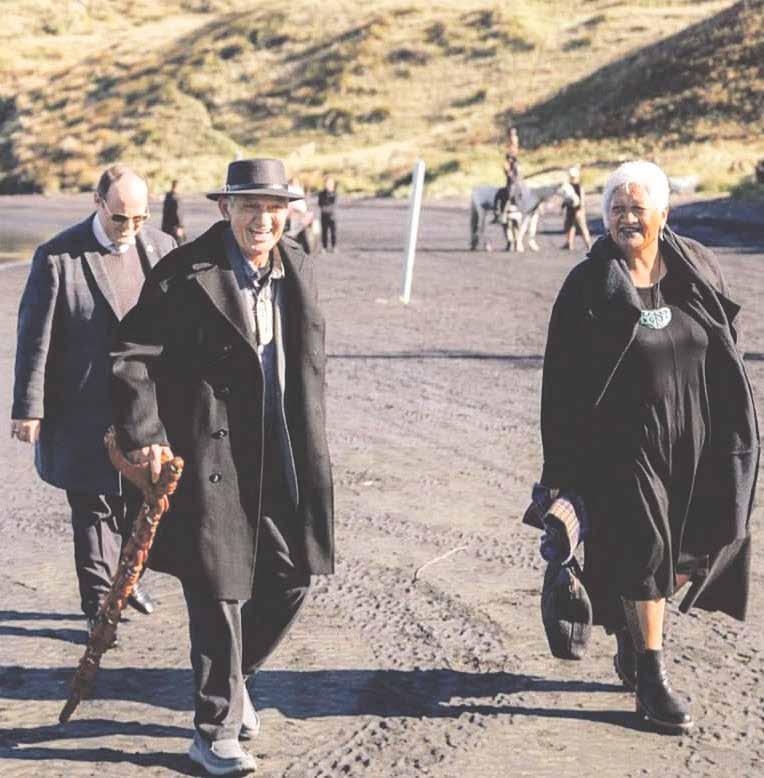

What’s a Russian tourist who has worked in IT in Israel doing in Ōtorohanga with Bill Millar? Find out on Page 3.

These Ōtorohanga Lions are helping the region’s firefighters up some stairs – read about it on page 5.

Why was it the last round last weekend for these veteran golfers? We find out on Page 12.





Bill Millar believes the town’s railway station is a superb tourism asset. It could be argued the Ōtorohanga railway enthusiast is one himself.
Bill regularly welcomes KiwiRail’s Northern Explorer scenic train to town, when it arrives on Monday, Thursday and Saturday mornings from Auckland and Sunday, Wednesday and Friday afternoons from Wellington. He greets passengers and will suggest places for them to get a meal or stay the night. He answers questions on local attractions and explains the history of the King Country. “We have this
opportunity to meet people on a one-toone basis; we must greet them with a smile, put a glow in their day and encourage them to stay in our region,” Bill said.
Back in 1993, he was instrumental in convincing the government of the day to continue Ōtorohanga’s rail services.
Bill arranged for her to have lunch in Ōtorohanga with some of his friends, including the district’s Mayor Max Baxter. He also arranged a lift for her to accommodation at Waitomo.
a machine it is produced by people.
If you produce a bad experience for a visitor, such as poor service or discourteous
remarks you cannot put a ‘stop shipment’ on it, as it has happened and it is already too late.
“Remember to be friendly to our tourists. We all need to be involved in our tourist and visitors’ needs and help them any way we can. Remember it is people who are remembered by visitors long after their memories of lakes, mountains, geysers and glow worms have faded away.”
In conversation it turned out that Daria came from a Russian village which is now in the firing line due to the war with Ukraine. She has worked in IT in Israeli city of Haifa and in Moscow.



He did the same again in 2006 and a third time in 2012, when he gathered 3000 petitions from Ōtorohanga, Kāwhia and Te Kūiti to retain the town as a stop on the Main Trunk Line.
Bill said the Northern Explorer represents an important gateway for local tourism and he would like to see its potential maximised.
On Saturday the former taxi driver was once again on hand to meet the Northen Explorer when it arrived from Auckland.

Bill chatted with party of six elderly cyclists who had come from Rotorua and Tauranga to board the train at Ōtorohanga and ride it to Taumarunui.
The group, who regularly cycle King Country roads, intended to cycle to Ohura and spend the night there. Their plan was to then press on to Piopio and, after staying another night, cycle back to Ōtorohanga via Waitomo Caves.
After wishing the cyclists bon voyage Bill welcomed a Russian tourist named Daria Kulikova, who was alighting from the Northen Explorer on her way to Waitomo Caves.
Daria was on a six-week-tour of New Zealand and Australia.
“I consider the tourist industry is selling expectations, not things. The product does not come off a factory line; it is not produced by
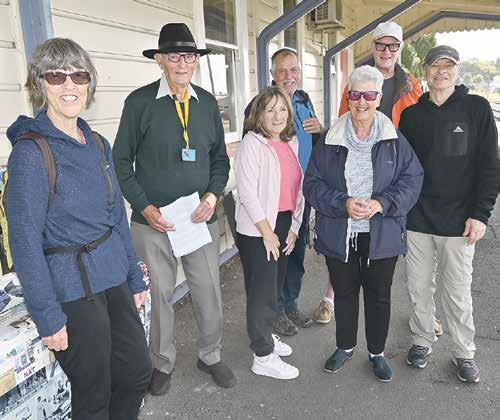
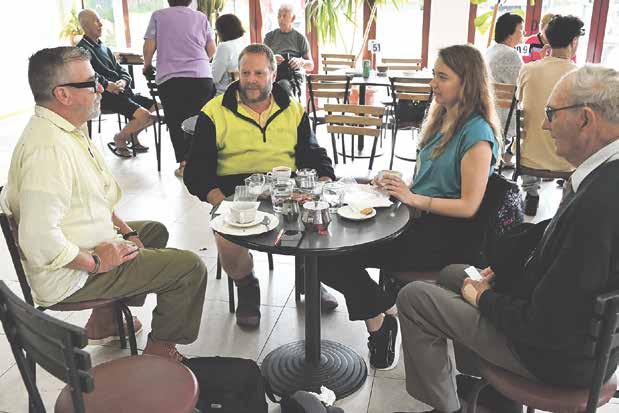


 By Paul Charman
By Paul Charman
Preparations to mark the centenary of the construction of the present Ōtorohanga Railway Station on June 8 are gathering momentum.
Trish and Lee Fisher, who run a cafe at the station, have permission to close off Wahanui Cres from 9am till 2pm for a street market on the day.
The event also comes with a dash of mystery.
It is hoped to put artwork created by the area’s children and written recollections from senior residents on the golden era of passenger rail in a time capsule during the event.
“We hope to use the railway station safe for this purpose,” Trish said.
But the safe has been locked for decades and the key can’t be found.
Is anything in the safe? That could be answered.
“We’re hoping that a similar key from the Taumarunui Railway Station will fit, but if not we’ll just have to build our own time capsule for the purpose.”
Trish said there would be historical photographic exhibitions at both the station and Ōtorohanga Library, with a colouring in competition also on display at the latter venue.
Meanwhile, plans were unfolding to expand the celebration right through
Ōtorohanga, with vintage cars and classic tractors to be on display and street performers expected to range through the CBD area.
KiwiRail had come to the party by donating two Auckland to Wellington Rail passes and residents from both Hillview Home, in Te Kūiti and Beattie Home in Ōtorohanga were supporting the event.
Some residents from the two rest homes would arrive the station this morning (Thursday April 18), to meet up with school children to tell them stories of the bygone era when passenger trains came and went from the station several times a day. These yarns would be the basis for artwork yet to be produced by the children, and some would find their way into the time capsule.
“We only really began seriously organising things in late February, but so far it really seems to be coming together well. One thing we have decided is to keep it local as much as possible. For example, there won’t be any food trucks coming in on the day as we want people to visit the local eateries in Ōtorohanga.
“Members of our team of volunteers have been amazed at the good will out there from both railway enthusiasts and the public at large. Everyone seems to love trains,” Trish said.
Ōtorohanga College had the X factor last week thanks to two “looping gurus” a hall full of passionate students and Creative Waikato.
X Factor 2015 winner Beau Monga and beat boxer ‘Matua Mixer’ (JJ Pakinga) performed at the school and also staged a workshop for students.
Later, Creative Waikato put on an outreach evening at The Business Collective in Ōtorohanga featuring musician Jonty Daniel and a question and answer session with Toi Māori artist Daniel Ormsby and Kiana Ormsby.
They spoke about life as multi-generational artists, their craft, ways to have a sustainable career in the arts, and lots of other gems.
“In this time of
increased pressure on artists, we think it’s important to celebrate and support our local creatives,” Leah Bell from
Creative Waikato said.
Creative Waikato’s React Tour 2024 is visiting 10 centres between now and June.
The tour is designed to will stage performances in rest homes and workshops in schools, and highlight talent.

Waitomo district needs half a dozen volunteer drivers to help mobility impaired resident stay active.
In return, the drivers will “get a great sense of helping people and supporting the wider community,” Desiree Brown from the Te Kūiti Community House said. The service helps clients to get to appointments ranging from social gatherings to funerals.
There’s no special licence neeeded, just a normal car licence, she said.
Clients are mainly older people and the service is considered especially valuable because social isolation can lead to an increased risk of dementia.
Clients do not necessarily ask whānau to help them, because they are conscious that its hard for employed family
members to get time off work, Desiree Brown said.
Volunteers are asked to commit to a day a week, or a day a fortnight at minimum.
The van travels around the Waitomo district, to places such as Maniaiti/ Benneydale and Piopio.
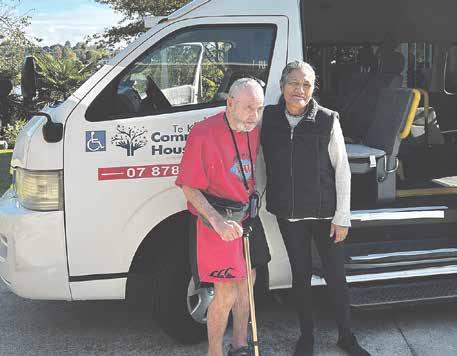
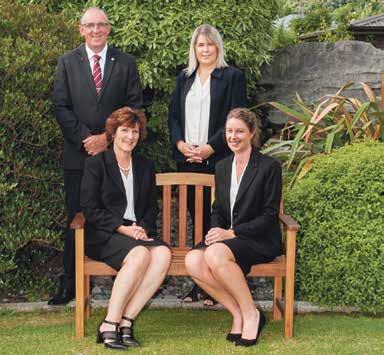




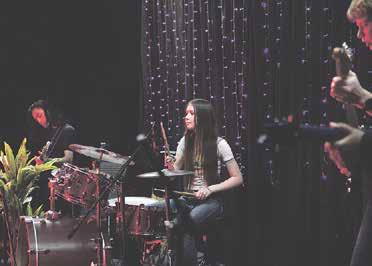
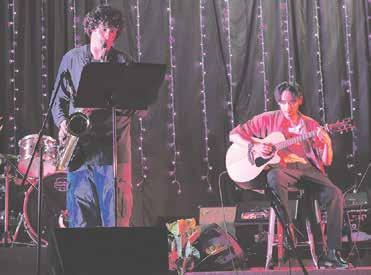

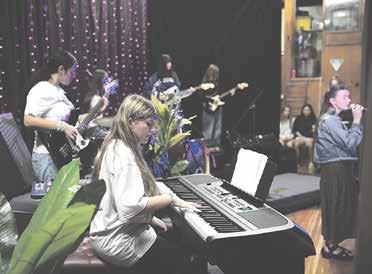

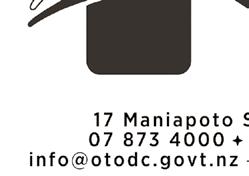
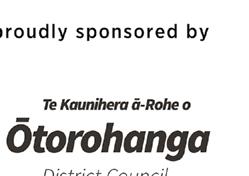
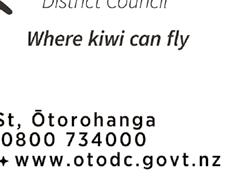





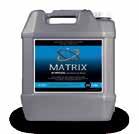
Selling second hand furniture and household goods has helped Ōtorohanga Lions sponsor the town’s fire fighters’ fundraising climb up the Auckland Sky Tower stairs this year.
The Lions are underwriting nine fire fighters from the district’s brigades, five from Ōtorohanga and, for the first time, four Kāwhia fire fighters.
A total of $9000 will go to the charity Leukaemia and Blood Cancer NZ (LBC) as
a result.
Lions president Malcolm Lister said firefighter Remko Pootjes had approached the club for assistance.
The Lions have made donations of $5000 and $4000 to the two brigades.
Sales proceeds from the Ōtorohanga Lions Shop go back into the community and have become the primary source of club fundraising, Lister said.
The onus was now on the firefighters to top their sponsorship by $500, team captain Remko Pootjes said.


“We do it for leukaemia [support] and the purpose is we all raise as much as we can, but we try and target $1500 each.
By achieving their targets, the brigade will get an automatic preference for next year’s Sky Tower Challenge.
Automatic preference is key to reentering the popular event, which is capped at a little more than 1000 firefighters who train for months for the opportunity to climb the 1226 sky tower steps in 25kgs of full gear, and wearing and or using breathing apparatus.
“All of us try and get that automatic
preference for next year because it is a very very popular event,” Pootjes said.
“The main reason why we are doing it is one in eight people in New Zealand suffer from some form of either leukaemia or blood cancer. And so it’s a way of making the population aware of the diseases as well as how we fire fighters raise the funds.”
The national foundation received no government funding but “with 1000 of us doing it we raise about $1.5m.”
This year’s event – the 20th – will be staged on May 18.








Are we getting value for money from the regional council? There are conflicting views. Paul Charman reports.
The Waikato Regional Council’s draft 10 year plan pitches a six per cent rates rise for the 2025 year.
Retired Ōtorohanga photographer Richard Wallace argues the council may be of some benefit for Hamilton residents, but it seems to deliver “zero benefit” to King Country communities.
The regional council is responsible for environmental management, including flood control, air and water quality, and pest control. It also regulates public transport, manages regional reserves and oversees bulk water supply.
Wallace thinks the $130 million paid annually in rates should be scrutinised.
“The amount, which translated to rates of about $318 for Ōtorohanga residents may be affordable for some, but within 100 metres of our home I know three or four needy families who find the rates a serious burden,” he said.
“I’d like to see some of the pressure the Government is now applying to reduce staffing levels and spending less in the public sector, also applied to the likes of the WRC.”
Federated Farmers regional meat and wool chair Reo Verry said with farmers’ incomes down and on-farm expenses up, any increase in rates is unwelcome.
But King Country River Care coordinator Anna Nelson said a six per cent rates rise was not unreasonable in the present inflationary environment, considering the amount of regulatory changes the Government has delivered to regional councils to administer.
“Add to this the fact that regional councils have more to do now because of having to implement additional regulatory changes because of the change of Government.”
Waikato Regional Council has put its 10-year plan, which includes rate rises, out for consultation. Residents have until May 2 to give their thoughts.
The council says the rate rise in year one is less than $50 for more than 80 per cent of ratepayers. However, those paying flood protection and catchment rates are likely to see larger increases.
The five topics being consulted on are:
• Increasing the natural

heritage rate to empower more communities to improve biodiversity.
• Collecting a region-wide public transport rate.
• Discontinuing the Regional Development Fund, so funds and staff time can be redirected elsewhere.
• Funding for Te Waka, the regional economic development agency.
• Changes to the funding of
the council’s rural compliance and support work.
Wallace remains unconvinced.
“I have been on my bike, cycling around this district for 15 years, riding north, south, east and west of Ōtorohanga and covering about 116,000 km. In that time, I have seen not a single piece of evidence of WRC doing anything worthwhile in our area.”
A bid by fraudster Bronwyn Rutter to move to Australia was thwarted recently – as a district court judge sentenced her to home detention.
Rutter, 67, had earlier been convicted of taking almost $1.6 million from an ailing older sister.
Judge Brett Cowley, in Te Kuiti District Court, sentenced her to 12 months’ home detention. He said there had to be a custodial element in her sentence.
“My recollection is she pleaded guilty on the morning of her trial, which was something of a late decision,” he said.
Rutter appeared for sentence on representative charge of theft from a person in a special relationship.
She had had an enduring power of attorney since 2019 and started taking money after her older sister was assessed as mentally incapable in March 22, the court was told.
Eleven times from March to July 2022
Rutter took money from her sister’s account –including $1.518 million to buy a house.
Rutter told her sister’s
lawyer the money was taken with consent – but the lawyer told her the sister wasn’t mentally fit to give consent and that Rutter was not permitted to make withdrawals.
Weir sought a sentencing discount of 20 per cent because of personal circumstances covered in a psychological report.
Prosecutor Baden Hilton – who sought a starting point of five and a half years jail – wanted the reparation of $67,607 for a vehicle Rutter had purchased.
Afterward the hearing a family spokeswoman said in a statement Rutter’s financial exploitation of their sister, sister-in-law and aunt was a despicable betrayal by a family member entrusted to care for her elderly and vulnerable sister.
“The ramifications of Bronwyn’s actions have irreparably split our family and will filter down through the generations for decades to come.”
“There are no winners in this case because we were once a tight-knit family.”


Need some direction to help you decide what to do with your future? Not sure if you should look at studying or try to find a job? Our Hei Tikitiki pathway programme will help you explore your options so you can identify the goals you want to achieve. Enrol now
Resurfacing of SH3 on Mt Messenger is on track to be completed by the weekend.
The NZTA system manager for ManawatūWhanganui and Taranaki, Liesl Dawson, said work was on schedule and stop/go road closures had so far been received well by motorists.
“We appreciate the closures were frustrating and we planned the scheduled openings to minimise disruption,” Dawson said.
“We are grateful for people’s patience during the current work to improve resilience on this stretch of the existing State Highway 3. We want to remind people to continue to factor in the stop/go delays into their journeys.”
Over the weekend Downer crews completed asphalt resurfacing with nearly 2000 tonnes of asphalt laid on the southern side of the mountain.
This would improve the condition and safety of the key access corridor.
Dawson thanked teams on the ground who had made the progress possible road users for their patience and understanding.
Meanwhile, Waka Kotahi says roadworks this week on SH30 and SH3, will cause delays.
Repairs to a slip 7km south of Te Kūiti on SH30 were being completed following a slip.
On SH3 a retaining wall and culvert is being built on the highway between Te Kūiti and the Eight Mile junction. Traffic management will be in place until the end of May.
SH30 north Maniaiti/Benneydale will be closed to heavy vehicles overnight on Saturday for rail crossing maintenance work.
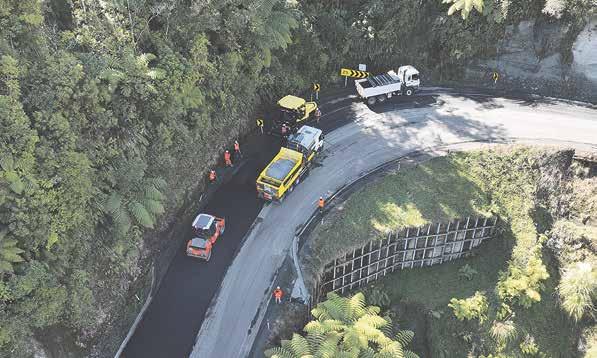
Over the coming weeks we’ll be undertaking an aerial survey of TLC-owned lines and equipment using drones.
The footage will help identify areas needing maintenance, repairs or even replacement of structures and equipment — keeping your lights on. It will also help us to keep our community and workers safe.
The survey is weather dependent. The aircraft will rapidly fly over TLC-owned lines and infrastructure — only taking video footage of equipment, not of private property, people or livestock.

Maihihi School raised about $2000 towards student camps and other adventures at its triennial market day last week.
Acting principal Phillipa Bourke said it left the community buzzing.
Grandparent Brian Gray enjoyed “the good bargains” and especially the Wood Boys’ gardening products while school dad Bruce Ahlers enjoyed catching up with friends, and fellow parent Carey Gray appreciated the students’ hard work.
Phillipa Bourke said the exercise had helped students learn business skills. “For several weeks students have been taking part in business enterprise activities as part of building financial literacy,” she said.
“They worked in groups to decide on products to make and sell. They created business plans,
and considered marketability and profitability,”
“Students were challenged to economically source materials to make their products, consider how quality products can best be produced and decide on retail cost, advertising and display. The whole experience has been hugely valuable for student learning.”
Heidi Ahlers, 8, reported that “tying up the string for our creations was the most challenging for me, while Robert Newson, 5, was happy to have “sold everything and got heaps of money.”
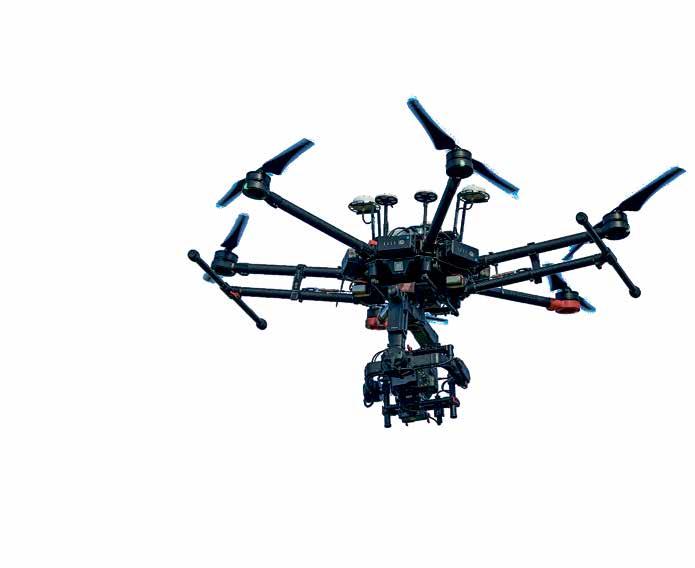
Reeve Gray, aged ten, later regretted being too generous with the mates rates.
“I don’t think we made as much money as we thought we would because we gave a whopping deal to everyone,” she said.





















A jaguar tooth necklace given to a Maniapoto delegation in São Paulo was presented to Kīngi Tuheitia at the recent Te Kūiti Pā poukai.
The taonga came from indigenous Brazilians – the original people of the city of São Paolo – via a group of seven Maniapoto descendants including Luke Moss and Te Miri Tamaki.
They had been visiting the country for four weeks on a Prime Minister’s scholarship.
At the Indigenous Cultures Museum in São Paolo, their guide introduced them to the three peson group, which included artist Andrey Guiana Zignnatto. “They weren’t supposed to be there – they are not recognised by the
An exhibition at Waikato museum is showcasing the Poukai tradition, in which whānau gather with the Kīngitanga to remember widows, orphans and the needy.
Poukai (marae gatherings) were introduced in 1885 by Kingi Tāwhiao, son of the first Māori king, Potatau Te Wherowhero, after the Waikato wars.
“Te Pani, Te Pouaru, Te Rawakore: Nurturing Generations through Poukai” will run until late July and features photographs from 2006 to 2008.
government,” Luke said.
Andrey was wearing the taonga when he arrived, and the Maniapoto visitors thought, ‘That’s a nice necklace’.
Andrey asked the Māori group a question, via an interpreter.
‘Do you have a leader, a chief of all chiefs? Someone who can unite the indigenous people throughout the country?’
“Yes we do – King Tuheitia,” they replied.
“Please give this to him,” Andrey said, handing over the taonga.
The Brazilian group said fate had led them to the visiting Māori group.
Luke said meeting with them was “like looking in a mirror.”
“Even though we’re separated by the ocean, we’re all working towards the same thing. They’re doing everything they can for their tribe, their language and their tikanga.”
The Te Kuiti poukai discourse included a controversial statement from broadcaster Kawe Roes.
He suggested younger people wanted to know some te reo Māori, but did not wish to be fluent in it. They also felt disconnected from the marae, Kawe reported.
Kaumatua Kingi Turner said the feelings described were “perfectly understandable” but that there was more to the situation.
“You get a broad spectrum of rangatahi… some of them are at that stage right now.
“What they’ve got to do is decolonise their minds – and that’s a challenge. Because we are being continually being mainstreamed in our way of living, thinking and talking.
“What I will say to them is, there is a pathway into the future where they will
really take ownership of te reo. Hopefully, you’ll get to the stage in your life, sometime soon, where you’ll learn a little bit more, and a little bit more after that.
“Once you become comfortable with te reo, you’ll be so happy. You’ll be connected. Not only to your reo and tikanga, you’ll
also be connected to words such as whanaungatanga and aroha, those values people hold dear.”
He said he knew a number of people who never thought they would speak Māori, but then fell in love with the language.


Over the coming weeks we’ll be under taking an aerial sur vey of TLC-owned lines and equipment using helicopters.
The footage will help identify areas needing maintenance, repairs or even replacement of structures and equipment — keeping your lights on. It will also help us to keep our community and workers safe.
The survey is weather dependent. The aircraft will rapidly fly over TLC-owned lines and infrastructure — only taking visual footage of equipment, not of private property, people or livestock.
More information
thelinescompany.co.nz
0800 367 546





Last week police attended two family harm incidents, investigated five burglaries and three wilful damage complaints. They processed a single drink driver.

































April 10: At 7.54pm police attended a collision on SH3 at Ōtorohanga. This involved a northbound driver who lost traction, over-corrected, and left the road. The car involved sustained minor damage but the driver was uninjured.

April 13: At 11.40am a car which had been doing skids collided with a parked vehicle on Te Kawa St. Police are following up leads to locate the driver.
April 8: Police located a woman they described as a recidivist shoplifter who had been seen shoplifting at New World. When apprehended she was also linked to shoplifting offences at two other shops. The woman, whom police said had been offending while out on bail for earlier shoplifting offences, will face various charges, including two for burglary, later in the year. She has been remanded in custody.
April 12: At 12.55 police attended a disorder incident in Rora St.
April 14: At 6am police were called out after a north-bound car skidded off Hangatiki East Rd. The driver, whose car left the road after they fell asleep earlier in the morning, was charged with careless driving.


At 9.32am police spotted a white Toyota car without a registration plate on Main North Rd. The driver was signalled to stop but instead took off. Police did not pursue the driver but believe they know the vehicle concerned and have launched inquiries to locate the driver.
Te Kūiti
April 9: At 10.30am police stopped a suspended driver at Hangatiki. He will appear at the next sitting of the Te Kūiti District Court.
April 10: Police located a man at Te Kūiti and served him with a parole recall warrant.
April 12: At 2.15pm police spotted a vehicle in Ward St which had been reported stolen. The driver failed to stop when signalled to do so. The same vehicle was seen on SH3 at Hangatiki on April 14, but when the driver saw police he immediately fled. Inquiries to locate both vehicle and suspect are ongoing.
On April 12 and April 14 police attended motor vehicle crashes at Waitomo both of which they put down to motorists driving too fast in rainy conditions. The first, at 12.15am, was at the intersection of Rangitoto Rd and Waitomo Caves Rd. This involved a tourist whose car slid off the road at the intersection of Rangitoto and Waitomo Caves Roads. The second incident was at 4.30pm in Waitomo Valley Rd. “We would like to remind motorists to drive to the conditions,” acting sergeant Gary Anderson said.
April 10: At 12.08pm police were called after a truck and trailer crashed on SH3, at Awakino. They said the heavy vehicle left the road after going too fast into a right hand bend.
Police attended one family harm incident.






















































An amalgamation discussion right now could be short and pretty one sided in Waikato.
A snap survey of Waikato’s civic leaders suggested the most do not buy into Waikato Chamber of Commerce head Don Good’s call that it’s time to discuss the existing local body political boundaries.
The News reported last week that one mayor - Waitomo’s John Robertson had already put his stake in the sand – but of a dozen leaders asked, he was only one of four to respond by the time we went to print.
Two said it would be inappropriate to comment.
“The councils in our region already work collaboratively. Amalgamation isn’t something that our council has discussed, so I feel it inappropriate to comment any further,”
Matamata-Piako’s Andrene Wilcock told The News.
“It’s not a topic that has been raised or discussed with our councillors or our community and it would be inappropriate for me to make a comment on the subject at this time,”
Thames Coromandel’s Les Salt said.
South Waikato’s Gary Petley was prepared to talk about an issue not discussed by his council.
“Amalgamation is not out of the question - if it can be shown to have benefits for our communities and – if there is an appetite for amalgamation from our community and ratepayers,” he said.
“Debt levels of neighbouring councils would need to be considered so as not to unnecessarily burden our own ratepayers. But it’s not just about finances and efficiencies. We must ensure that our communities’ interests are aligned.
“Amalgamation can challenge a community’s inherent sense of place and interest. Business cases for amalgamation must extend beyond simply bolting councils together. This alone won’t realise financial benefits.
Councils and communities will still need to do the hard work of rationalising facilities, staffing and service levels. Most communities have little tolerance for losing their local library or pool for example.”
Robertson said he didn’t have views on other areas – just the two smallest in the region –Ōtorohanga and Waitomo.
“To me it’s a no brainer and would bring advantages to the ratepayers of both districts,” he said.
Four principles should drive council area definitions, he argued.
They were the ability to gain economies of scale and spread overheads, having a community of similar interests, enough scale to attract professional staff and to procure goods at competitive prices –and protect local democracy.
He gave ticks to all four for Waitomo and its neighbour Ōtorohanga.
The call to suggest a Waikato super council is not new.
Former Hamilton mayor Margaret Evans appeared before a select committee to back that idea in 2009.
The influential group she led included former mayors John Hewitt (Waipa), Eric Tait (Ōtorohanga) and Angus Macdonald (Waikato).
One Hamilton councillor, Dave Macpherson – who retired only last year – called the plan a “spectacular brain explosion”. Former Waipā mayor Alan Livingstone suggested such a move would be “on our town time” and not through rushing to Wellington to ask the government to decide it.
At the time Evans noted “how can you expect someone who’s occupying a seat that’s going to disappear to have a positive response?”
• What do you think? Is it time for a merger discussion? Send us your thoughts in a letter to the editor.

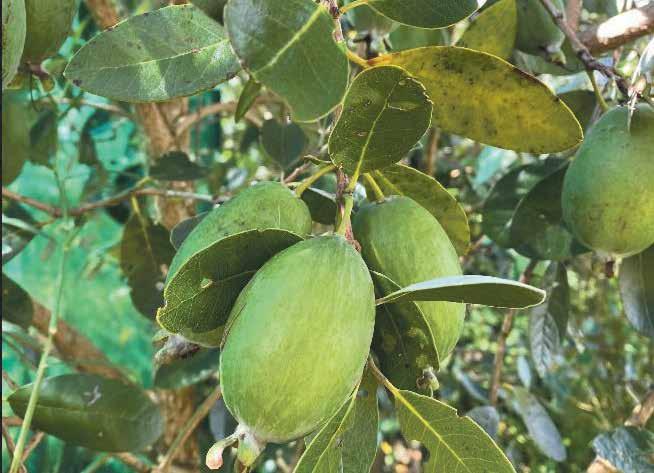
If you don’t already you should plant a Feijoa or two so you can enjoy home grown yummiest next year.
Some great varieties that I would recommend are:
Apollo - are medium to large size with excellent sweet flavour, Early season. Partially self-fertile, so will produce some
fruit if planted alone, but will produce larger crops of bigger fruit if planted with another variety nearby. Vigorous upright growth habit.
Mammoth – medium to large fruit, sweet, soft & juicy. While it is partially selffertile, better crops are achieved when planted with another feijoa cultivar.
Opal Star - A late season variety with smooth dark skin with fabulous rich and aromatic flavour. Compact, slow growing plant that has bushy habit so ideal for

home gardens, especially for hedging.
Unique - As a self-fertile variety, Unique is a prolific bearer of fruit from a young age. Medium size fruit with smooth, soft and juicy flesh. Early season. If you only have room for one Feijoa tree, plant Unique as it’s the only truly self-fertile variety.
Wiki Tu - Huge fruit on a dwarf growing (2.5m), easily managed and slow growing tree. Sweet and meaty fruit with firm texture and good keeping qualities. Midlate season. Partially self-fertile, though is best with another variety nearby for cross pollination.
One great aspect of growing feijoas is their resilience and low maintenance requirements. Feijoa trees are relatively hardy and can tolerate a range of soil conditions, as long as they are welldrained. They are also fairly drought-tolerant once established, making them suitable for regions with inconsistent rainfall.
Another advantage is their attractive evergreen foliage, which adds ornamental value to gardens even when the fruit is not in season.
Feijoas are easy to trim, which should be done after fruiting, as fruit is produced on fresh new wood which grows in spring. Additionally, feijoa trees produce beautiful, edible flowers in spring, which attract pollinators like bees and butterflies.
If you a planning a small new contemporary garden and would like to include a small Wiki Tu amongst your planting, I would suggest something simple like a mix of Westringia fruticosa ‘grey box’ & Rosemary trimmed into a balls, with a our native ground cover Pimelea prostrata blue peter and maybe some Phormium ‘Emerald Gem’ for some contrast.
The possibilities are endless really, if you need help re-vamping or designing your garden, I recommend contacting a Garden Designer.
This week’s column proudly sponsored by


A golfing trophy that has kept two teams in contest over a quarter of a century will now rest in peace on Te Puke captain Ross Underwood’s mantelpiece.
The last Tarabop Trophy match was held where it all began in 1999, at the Waitomo Golf Club. The name on the toilet seat refers to the two teams from Taranaki and the Bay of Plenty. The colours are meant to be a combination of the two provinces rugby
Proudly supported by
teams, but there is a lot of yellow, and only one stripe of blue and one of black.
The respective regional captains were brothers in law. Over the decades the teams have contested the trophy on golf courses from Invercargill to Kerikeri, with wives and partners receiving a special invite to the 10th anniversary challenge in Queenstown. Covid was the only interruption to the continuity of the event.
The same teams from the Waitomo match in 1999 returned this month for their final hurrah.
April 15: Cars hit cattle wandering on SH3
Two cars were involved in a collision with stock wandering on SH3 at Hangatiki, just before 7pm on Sunday. The incident took place near the bridge, just south of the Big Apple.
Police said one car struck two calves and then a few moments later the second car hit a cow near the same spot. It is understood the drivers suffered moderate injuries but that the cattle had to be put down at the scene.
The Ōtorohanga Volunteer Fire Brigade conducted traffic control until ambulance staff arrived to take care of the injured.
Police said they informed council animal control officers of the incident, whose inquiries are ongoing.
Te Kūiti
April 10: At 9.59 am the brigade was called out to Te Wharekura o Maniapoto, Oparure, following an automatic fire alarm activation.


Te Kuiti 07 878 5169
”It’s fair to say most of the crew have some sort of ailment that hinders the joy of participating like we once did,” Bay of Plenty team member Barry Smallridge said. “Ross Underwood captain of Bay of Plenty has written a book on the trials and tribulations of living life with Parkinsons, The River Dancer is a must read.”
April 14: At 9.32 am the brigade responded to smoke rising from a property in Piopio but they were turned back enroute. At 11.07am they were called to the scene of a crash involving a car which had gone into a drain on Hangatiki East Road. No injuries were reported so the brigade assisted with scene security until police took over. At 7pm they were called to small rubbish fire in Mangarino St but the fire was out on arrival.
April 8: At 5.26am crews from Piopio and Te Kūiti responded to a single vehicle crash on Troopers Rd. A car had rolled off the road ending up on its side. The sole female occupant was uninjured.
April 9: At 4.12 pm crews from Urenui, Mōkau and Piopio were called out after a south-bound truck and trailer rolled on SH3 in the Awakino Gorge. No injuries were reported. The Piopio brigade secured the scene and assisted police with traffic control till roading contractors took over. At 6.46 pm a crew from Piopio were called to Piopio College sports ground to secure a landing zone for a patient to be evacuated by the Waikato Westpac Rescue Helicopter.
April 14. At 9.30 am crews from Piopio and Te Kūiti turned out to check on smoke in the vicinity close to SH3 in the ground of the Mōkau Kohunui Marae. This turned out to be a controlled burn and no action was required.
April 2: At 6.01 am a truck rolled at passing lanes on SH3 north near Kio Kio. There were no injuries and the brigade and the brigade handed scene over to the police
April 5: At 7.55am a car crashed through a fence at Kio Kio but there were no injuries reported.
• Ōtorohanga 07 873 6385 Taupo 07 378 8545 www.actionelectrical.co.nz
Te Kuiti 07 878 5169 • Ōtorohanga 07 873 6385 Taupo 07 378 8545 www.actionelectrical.co.nz
The final was extended to a second day in Putāruru, where Te Puke emerged victorious.
April 11: At 12.54pm trees were reported to be on fire on Turoto Rd, Honikiwi. The cause turned out to have been a burn-off which got out of control after the wind picked up.
 The Taranaki team from left Beau Burmester, captain Brett Gould, Kerry Hamilton and Mark Irving - and Te Puke - Steven Nelmes(rear) Barry Smallridge, Gavin Farquhar, and captain Ross Underwood.
The Taranaki team from left Beau Burmester, captain Brett Gould, Kerry Hamilton and Mark Irving - and Te Puke - Steven Nelmes(rear) Barry Smallridge, Gavin Farquhar, and captain Ross Underwood.

‘The National Army Museum (Te Mata Toa) in Waiouru, is preparing for an influx of visitors with both the school holidays and Anzac Day just around the corner.
The museum tells the stories of ordinary men and women enduring in extraordinary circumstances and its popularity has been steadily building over the years.
It has an interactive Kids HQ, hands-on activities, guided tours, family research, military themed café and gift shop, plus special Anzac Day events.
At the heart of it all is “The legends this Anzac Day” which recounts stories of courage, honour, and sacrifice.
The museum holds an 11am civic service on Anzac Day itself (25 April). This is supported by the NZ Army with soldiers on parade; a catafalque guard; an Army bugler and flag marshals.
Attendees will be able to hear the words spoken out loud of those who fought at Gallipoli and lived to tell the tale with “Voices of Gallipoli”, a three-day international act of remembrance.
This activity blends the historical with the contemporary, providing a unique experience not to be missed.
So what does Anzac Day represent?
ANZAC is an acronym for the Australian and New Zealand Army Corps, a group of several divisions that fought together in World War I.
At dawn on 25 April 1915, Allied troops (including the Anzacs) landed on the Gallipoli Peninsula in Ottoman Turkey (pictured).


They’d intended to knock Turkey out of the war and control a strategic sea passage to Russia.
But the Turks had other ideas and steadfastly defended their homeland.
The cost of the campaign was more than 200,000 lives on both sides as it became a bitter, entrenched battle.

In particular, the cost for New Zealand was undeniably immense.
Approximately 3,000 New Zealanders landed at Anzac Cove at dawn, 25 April 1915. But the end of the day, about 20% had become casualties, signalling the beginning of a bitter and fierce campaign that would not see the ANZACs leave until nine months later.
Ultimately, the campaign cost the New Zealand Expeditionary Force some 7,500 casualties, of whom 2,721 were killed.
History remembers the Gallipoli campaign as a disaster for the Allied Forces. But it was just as costly and bitterly fought for by the Ottoman Empire, which sustained over 250,000 casualties (including nearly 90,000 killed).
The bonds forged on the Peninsula have created something special.
At Gallipoli’s Ari Burnu Cemetery where 31 soldiers from the New Zealand Expeditionary Force are buried, there is a memorial inscribed with a unique inscription.
It is a quote attributed to Mustafa Kemal Atatürk,
the first president of the Republic of Türkiye that reads:
“Those heroes who shed their blood and lost their lives… you are now lying in the soil of a friendly country. Therefore, rest in peace. There is no difference between the Johnnies and the Mehmets to us, where they lie side by side here in this country of ours. You, the mothers, who sent their sons from far away countries wipe away your tears; your sons are now lying in our bosom and are in peace. After having lost their lives on this land they have become our sons as well”. Atatürk, 1934
For many in New Zealand, the word “Anzac” invokes a feeling of pride, solemnity, remembrance, and respect.
It is part of a shared culture between New Zealanders and Australians, brothers and sisters in arms; the spirit of the Anzacs to endure despite the extraordinary odds against them.
It represents a shared grief by two countries for a bloody, bitter, and costly battle. Perhaps every New Zealander should take a moment this Anzac Day to find out what “Anzac” means for them personally. The Museum is open daily 9.00am to 4.30pm. Find out what’s happening these school holidays and Anzac Day at the Museum: www.armymuseum.co.nz.


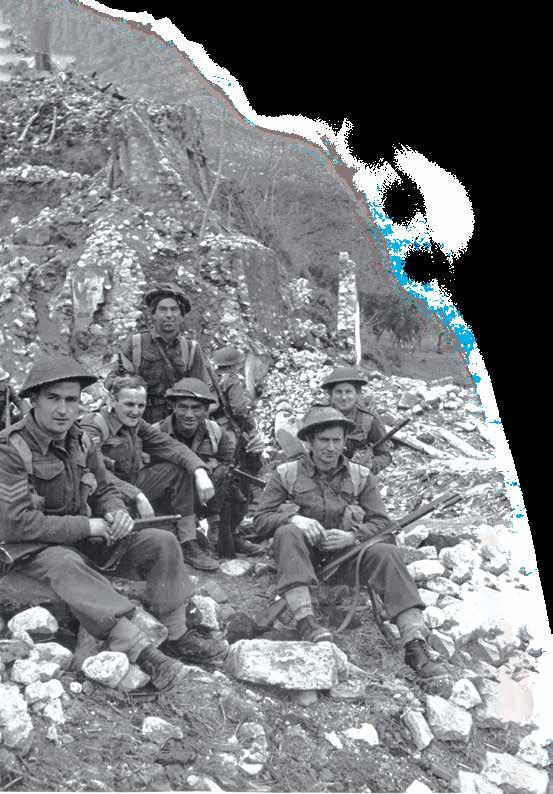
In early 1944 the New Zealand division was fighting at Monte Cassino, one of the most brutal and costly battles of the war.
Winter weather with torrential rain, mountainous terrain and a well prepared and equipped enemy awaited the allies who were attempting to move north towards Rome.
The 500m Monte Cassino dominated the route to Rome through the Liri Valley. Below it was the Rapido river and the heavily defended town of Cassino.
Several Allied attacks failed before the New Zealanders arrived. Overall there were four main engagements - the first from January 17–February 11, was fought by French, French colonial, and U.S. troops.
The US 141st Infantry Regiment crossed the Gari river in two battalion strength and, despite the lack of armoured support, managed to advance 1 kilometre (0.62 mi) along the river flats. But they were cut down in daylight, losing 2000 men.
By the evening of January 22, only 40 men from the 141st Infantry Regiment made it back to the Allied lines.
While the Americans attacked across the marshy bottom ground of the river valley, the Germans held the surrounding rocky heights, from where they could fire down on the allies.
Their focus increasingly shifted to the commanding height of Monte Cassino which dominated surrounding countryside. Enemy positions on the high ground had to be seized.
A second assault from February 15–18 was controlled by the New Zealand and 4th Indian Divisions and involved an attack on the famous monastery. The New Zealanders lost 1600 missing, dead, and wounded men. Indian losses were 3000.
British divisional commanders demanded the



destruction of the historic monastery on the top of the mount. Even though the Germans formally declared their troops would not use the building. It later turned out the Germans had evacuated the monks and the art treasures housed at the abbey. While their troops did not station themselves in the monastery, they positioned themselves immediately below its walls, making the historic structure a target.
Allied commanders ordered an air attack that involved 250 bombers that dropped 600 tons of explosives. On February 15 the monastery was flattened and the ruins provided Nazi paratroopers an excellent defensive position.
Assaults on the monastery over the next two nights resulted in the Royal Sussex Regiment losing 12 out of 15 officers and 162 out of 313 men who took part.
Another assault on February 17 was commanded by New Zealander Lieutenant General Sir Bernard Freyberg.
His plan included an attack by Ghurkas from the north along the mountain ridges and an attack from the southeast along the railway line, and to capture the railway station across the Rapido less than 1 mile (1.6 km) south of Cassino town. Success would squeeze out Cassino town and open up the Liri valley. Freyberg told his superiors he estimated that the offensive had a 50 percent chance of success.
Two companies from the New Zealand Division’s Māori Battalion forced a crossing of the Rapido and attempted to gain the railway station in Cassino town. The goal was to create a perimeter that would allow engineers to build a causeway for armoured support.







During her childhood, Sonya Fagan’s shearing contractor dad, Craig Fagan, discouraged her from the industry.
But at the recent New Zealand Shearing Championships, Sonya gained valuable experience when they shore together in the whānau event.
She appreciates the mentoring – both in competitions and in the sheds.
“When I’m with Dad, I tell him ‘I’m having trouble here, what am I doing wrong?’ And then you do it and you click, and you’re like, ‘I just did it way faster.’”
The story begins with reluctance: on both sides.
“If I’m being brutally honest, I’ve done everything I can to talk her out of it,” Craig said.
“Because I know the reality of the industry. It’s not easy. Even as a bloke it’s tough but for women, they’ve not got the advantage of strength, and it’s tougher again.
“No one wants to see their children struggle. But 20-year-old Sonya, who “doesn’t do things by halves,” insisted on giving it a go. And Craig ultimately picked up on her passion and became a supporter.
“Being quite headstrong, she’s decided this is the path she wants to go down. So I’ve said, OK, if you are going to go this way, the least I can do is give some insights to help you,” he said.
“I wanted to make sure this was what she really wanted to do. Because it’s not an easy road.”
At first, even Sonya herself didn’t want to go shearing.
And for some time, it wasn’t an option for her, or any of her siblings.
“We had a rule in our house that you weren’t allowed to pick up a handpiece until you were 18, because you can wreck your body if you do pick it up any sooner,” Sonya said.
That didn’t mean the young Fagans weren’t involved; Sonya started wool handling at 12. And that was behind part of her reluctance to shift to shearing.
“I didn’t really want to go into the sheds because I’d been doing it for so long and I wasn’t keen.”
She originally wanted to join the Navy, and also later went to uni, but health affected her progress in both areas.
Only after that did her mind turned to shearing.
Around that time, Craig organised for the two to go over to Australia, working in the sheds, and Sonya loved the atmosphere as a wool handler.
“Over there, you throw big Merino fleeces and there’s a lot more work to do on the fleece, they care a lot more.”
Craig suggested she “do the last side” of some of the sheep.
“When we came back, Dad said, ‘do you want to do a shearing course?’
I thought, I’ll give it a go, I thought, this could be a good way to make money and travel the world. That was in 2022.
The course was run by Piopio’s Mark Barrowcliffe. That’s when Sonya first shore a sheep by herself.

There’s never been a better time to jump the fence. When you get into a new relationship with us, we’ll guarantee the future resale value of our tractors.
Tempted? Get in touch today.
Another inspiration was record-holder Sacha Bond, who helped her choose handpieces and provided consistent encouragement.
When Sonya spoke to King Country News recently, she was back from a year overseas in Norway and the UK.
At the end of the recent Scottish main shear she shore her first 100.
“That’s the hardest tally you’ll do, because you’re not used to it. You get thrown in the deep end.”
Young shearers aspire to get there in eight hours, but Sonya did it in just six.
Since returning home this year she has shared a stand with gym buddy Chloe Bingham.
“After New Years, we both got a crack at our 200 and we both got that. We were so happy.”
Shearing has been “a bit of a journey” and frustrating at times.
“Strength is my worst challenge. I’m not a big girl – so trying to pull ewes out all day is a struggle. They can be pretty big and strong.” Craig added, “Most of them would be bigger than her.”
Sonya said there were “no days off,” in the shearing season, with tiredness and fatigue a reality.
“You work from after New Year’s straight through to the end of January. You’ve got to have the right mindset to get past all of that.”
“The sheep do kick you and you’ve got to deal with it as well.
“If you get kicked real bad, you’ve just got to get back in your pen really.”
Sonya has collected a few shearing ribbons, placing third in the women’s event at the Gore
show. All women were in the same class.
“I was talking to my uncle David (Fagan) at the show last week. He was helping me a lot with my gear and talking to Dad on the phone trying to get me into the right headspace.
“The more practice you get, the better you will get at it. I’m just trying to learn to have fun with it instead of worrying about where I come.”
Sonya’s goal as a shearer is to do a record one day, perhaps when she’s 30. She’d also like to win one of the big shows.
“That’s the long-term goal. But who knows what’s going to happen between now and then?
“I might do a whole main shear next year and not enjoy it. But you’ve got to have a goal.”
At first it felt “very pressured” to be a Fagan starting out in shearing.
“You go up on stage and they say, ‘she’s from the famous Fagan family.’ You are really nervous, especially overseas.
“I just try not to worry about it too much. Try not to let the pressure get to you, that’s the main thing.
“That’s why I had a hard-ish couple of shows before Gore, everyone was like, ‘you should be doing better than that because you’re a Fagan.’ Her next plan is to go to the main shear in the UK. She doesn’t want to run a gang like her dad though: “that’s way too much dealing with people.”
Otherwise, she’d like to go farming and “live a simple life. You don’t have to get stressed every morning about people turning up to work.”





“This industry isn’t for everyone. It is a hard industry to get into as well – contractors will give you a job if you’re reliable and you can go somewhere in life. I’ve had a great couple of years travelling.”
“It is still harder for girls to shear than boys to shear, because you haven’t got that strength, if a girl wants to shear – I think girls are a lot
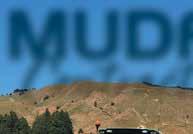
calmer than boys naturally, most of the time.”
“I love to see women shearers that come up. Me and Chloe have had the same tallies coming up through the main shear, and it’s great to see that other women shearers are happy for you.
“Any girl can conquer this job with the right mindset.”


The Climate Change Commission is considering adding emissions from international shipping and aviation to New Zealand’s 2050 carbon emissions target. Chair Rod Carr said the commission was keen to get feedback before making a recommendation.
Four contenders are in the running to be named Fonterra Dairy Woman of the Year. Myfanwy Alexander (Otago), Amber Carpenter (Auckland), Katrina Roberts (Matamata), and Michelle Ruddell (Whangarei) are chasing an award that comes with a scholarship to be part of the Kellogg Rural Leadership
Kids think big
Waitanguru residents were “pump-ked” about their veggie contest earlier this month, which was combined with a pot luck dinner and Easter egg hunt. Dayna Holms won the award for biggest pumpkin, with spot prizes for the smallest and most unfortunate veggies also on offer... some of which looked a little squashed. The community enjoyed their sense of (pump)kin-ship to carve out a moment of fun.
Programme. The winner will be announced in New Plymouth in early May.
Dairy farmers can expect ‘marginal’ tightening of their financial position next season with less revenue forecast, DairyNZ Head of Economics, Mark Storey says.
“We are not expecting feed and fertiliser costs to drop much further than they have already done and while debt servicing may ease, it will likely remain at very high levels,” Storey said. The break even milk price for the 2024-25 season is forecast to sit at around $7.76 kg/MS, while the forecast payout received is $7.79 kg/MS.
Jacqueline Rowarth has been appointed to the new Dairy NZ deputy chair position.
The farmer elected director will provide additional support in the area of stakeholder engagement chair Jim van der Poel said.
One of DairyNZ’s key roles is to put forward evidence-based solutions that work for farmers and rural communities and help move dairy farming into the future, Mr van der Poel said.
“This Deputy role will help support our
Board’s work with our sector, industry and science partners, and with local and central governments to fulfil that commitment.”
The board felt it was important to have a nominated deputy chairperson to represent DairyNZ at a governance level on issues that matter to levy-paying dairy farmers. It was a key role to support the effort DairyNZ was putting into ensuring a thriving dairy sector for its farmers, he said.
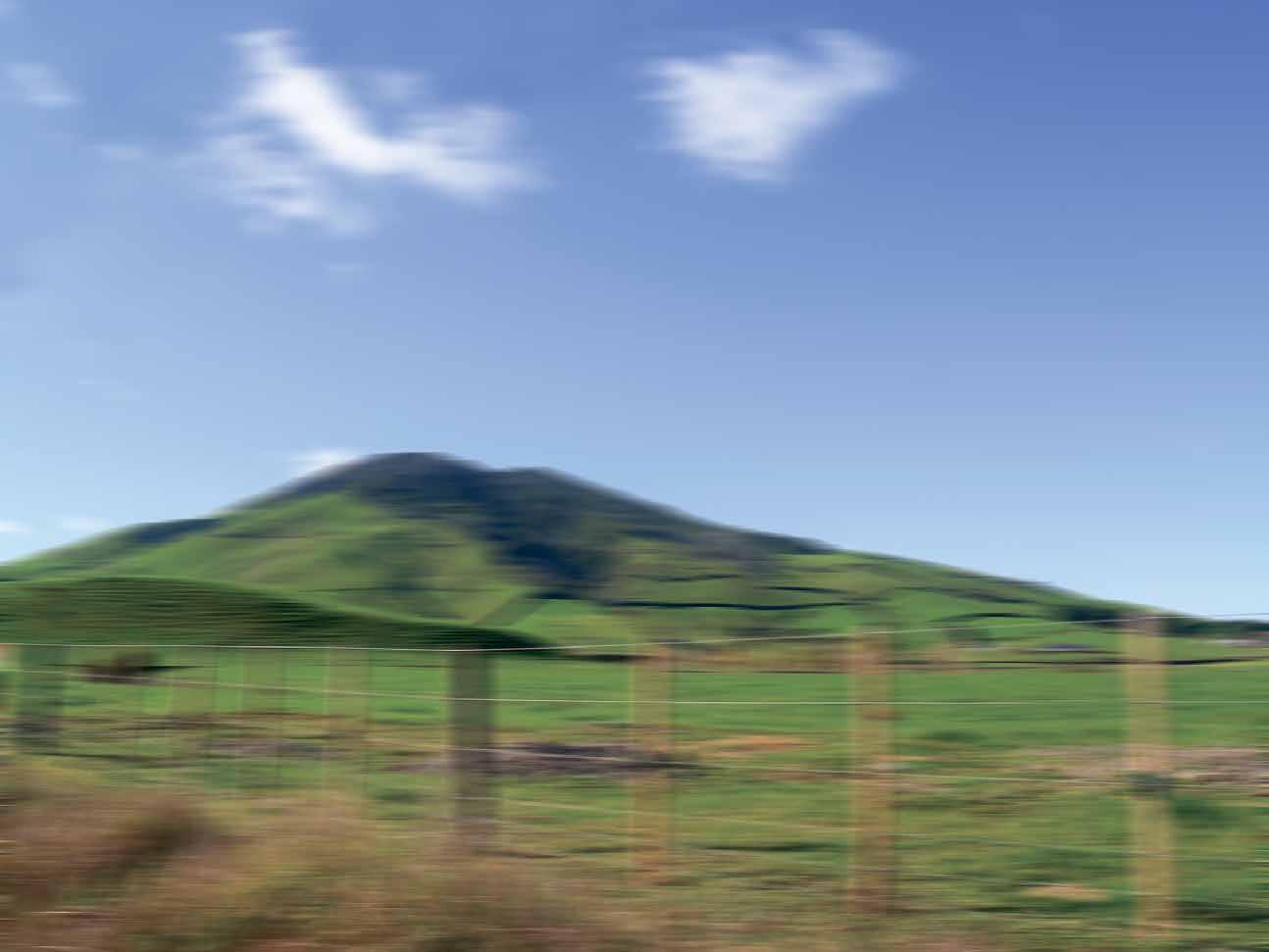


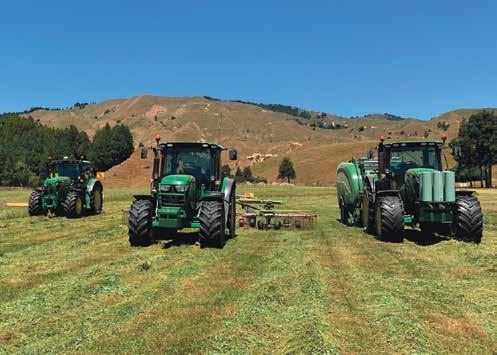


Following three crashes involving tractors in Waikato over the Easter break, the board of Rural Contractors NZ has been discussing ways to improve safety.
A spokesperson said the subject came up at the organisation’s last regular board meeting, after three crashes on Easter Saturday.
“Board members reported feedback from contractors that it was often hard to let people pass because of road works, wire ropes, or steep banks at the sides of highways.”
The board will consult members to gather more information on how serious the problem is.
Meanwhile, a Ministry of Transport spokesperson has denied rumours that it is preparing to regulate the movement of tractors using the national roading network to move from one farm to another.
“There is not currently a review underway in relation to the rules for tractors on the road,” the spokesperson said.
“However, the Government will be considering its work programme and priorities for improving road safety over the next three years as part of developing its new road safety objectives.
“The new road safety objectives will replace Road to Zero. The Government is committed to continuing to reduce death and serious injury on our roads.”
On Easter Saturday two people were seriously injured after a car and tractor collided
on Oparure Road, near Te Kūiti.
Just 10 minutes later a motorcyclist was critically injured after a crash involving a tractor in the Matamata-Piako district. The rider later died in hospital from his injuries.
Then at 9.45pm on the same day, a tractor crashed into a car at the intersection of Pond Rd and SH 29 (the road over the Kaimai Range), leaving four people injured.
Police said they had noticed a growing number of tractors on Waikato roads as farmers took advantage of the dry weather to cut maize and make silage in preparation for winter.
“We know that it can be frustrating to be stuck behind slow-moving agricultural vehicles, but we’re asking motorists to be patient and only pass when it is safe to do so.
“Similarly, we’re asking those on agricultural vehicles to be mindful of traffic around them, and to pull over and let traffic pass when it is safe to do so.”
Police said all drivers needed to focus on the basics, including watching speed, not using the phone while behind the wheel, avoiding driving while impaired (including being fatigued), and making sure everyone had their seatbelts on.
NZTA senior media manager Andy Knackstead said in general terms, tractors being driven on a public road had to follow the same road rules as everyone else.
“They must be in good condition and be safe to use on the road. Those driving tractors are also responsible for checking that the tractor is





The
not over-width and has the correct signage.
“There are tips for other road users on sharing the road with tractors in the NZ Road Code. You will sometimes see tractors and other farm or construction machinery on our roads.
“So, because they are large and usually travel slower than other vehicles, you need to be especially careful when driving near them,” Knackstead said.
NZTA recommended the following around large tractors:
• Begin to slow down as soon as you see a
tractor ahead of you and watch out for any warning beacons.
• Be patient while driving behind tractors – a few minutes of travelling at a slow speed is better than risking a crash.
• Be extremely careful when passing and only pass when it is safe and legal to do so
• Remember that tractors often have wide or long loads, which can make passing more difficult.
• Be especially careful around tractors that have just stopped, as they may actually be about to turn.




Land sales to foreign carbon farmers will be streamlined by the Government’s decision to shift the processing of applications from the Overseas Investment Office to Land Information New Zealand (LINZ). But there are polar views on whether or not the change is needed, or good. Labour Party spokesperson for land information Damien O’Connor said the move could mean less political involvement in the process of foreigners buying farmland to create carbon plantations.“Regions like the King Country could see a significant impact.“Effectively, when these changes made to the way applications are handled, foreign owned carbon companies will find it easier to purchase New Zealand farms. The government is opening the door to more foreign buyers,” O’Connor said. Normally the ministers for land information and finance give the final tick of approval for any land sales through The Overseas Investment Officeincluding the sale of farmland for conversion to forestry. But these powers would now

be delegated to LINZ. Minister for Land Information Chris Penk said the move will speed up the application process and reduce uncertainty for investors.“These changes will help encourage overseas investment which is an important part of the government’s plan to rebuild the economy so we can provide the public services that Kiwis deserve.” LINZ already make most decisions on applications, there have been no changes to the investment criteria and ministers will still have visibility of applications as they come through. Penk said ministers will still make decisions related to national security assessments and retain the ability to decide applications of particular public importance.
But O’Connor said the change was concerning and unnecessary. The Government has been “speaking out of both sides of its mouth” - with New Zealand First still saying it is out to reduce land sales to foreigners while the National seeks to increase sales to boost revenue. Federated Farmers is not concerned about the move.
“In relation to sensitive land, all this letter does is delegate approvals”, said Federated


Farmers national board member and forestry spokesperson, Toby Williams.
“It doesn’t change the criteria for assessment or anything else, and Ministers retain the right to call in an application if they feel like it.
“We would certainly be very concerned if the government were to make it easier for overseas investors to convert farms into forestry. This sort of land use change that takes out productive farmland in favour of ‘blanket’ planting of monoculture pines, especially when it’s for carbon credit income rather than for harvest of timber, undermines employment and the viability of rural communities. There are other fire risk and pest control downsides.
“But we see nothing in this that increases the risk of such applications from overseas investors gaining approval.”
The chairperson for the anti-carbon farming organisation 50 Shades of Green, Andy Scott, is also unconcerned about the changes.
“During the Labour tenure they introduced a policy that fast tracked overseas investment for forestry, however they basically excluded any overseas investment into farmland for


agricultural purposes,” Scott said.
“During Damien’s period as Minister for Agriculture there was a huge conversion to carbon farming that is now irreversible. All this did was escalate the foreign ownership and carbon farming, yet if a farmer wanted to sell the only overseas person that could purchase their land was a forestry investor. Therefore, farmland was once again made easy to purchase for carbon farming.
“Without investigating fully, I would say that this change National has put in place will make no difference to foreign ownership of farmland.
“If they make it easier for foreign investors to purchase land for farming and not the corrupt investment into carbon farming then I think that is a good thing. As when a farmer wants to exit his property for whatever reason, then it is an open market and not a biased market.
“Whatever National do to reverse the past eight years I believe will be an extraordinary hard task. I only wish that politicians would learn that a decision made has consequences and we the New Zealand public will be paying for decades.”



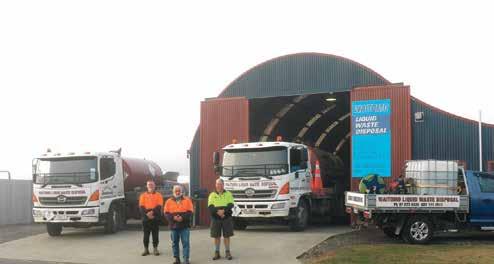

In today’s economic climate, we are seeing many people struggle with the rising cost of living. A big chunk of the rising costs can be attributed to mortgage repayments, as well as skyrocketing food prices, petrol, and utility bills. People that purchased properties several years ago when mortgage interest rates were relatively low, sitting around the 2.50-3% mark, are finding their mortgage coming off those low fixed rates and increasing to upwards of 6.50-7.50%, increasing their fortnightly or monthly mortgage repayments by hundreds of dollars. Shopping around for better rates has led to an increase in refinances over the last year. Refinancing is commonly known as replacing your current mortgage with a new one, either with your current lender or a new one, to receive better terms or to borrow more money.
Refinancing comes with many pros and cons. The biggest pro of refinancing is that it can help people who are cashstrapped to free up some money in their fortnightly or monthly budget as refinancing often gives people a lower or better suited interest rate. Refinancing to a better rate can help alleviate the financial pressures many people face today. The biggest con of refinancing is the cost involved in a refinancing transaction. Many people do not realise that they will need to instruct their lawyer to act on this transaction on their behalf, which attracts legal fees of upwards of $1,500 or more. For people who are already struggling financially, this cost can cause added stress. However, some banks offer cash contributions in refinancing matters and these funds can be used to pay the legal costs incurred.
If refinancing is looking like a good option for you, please consult with your mortgage broker or bank manager to explore your refinancing options and instruct your lawyer once you have decided to refinance your property.

•
•
•
•





Forensic work is underway to determine how an invasive weed arrived on Waikato farms –and where else it might have gone.
The discovery of velvetleaf on two new properties in the Waikato region has sparked a renewed call from Waikato Regional Council for robust biosecurity measures on farm.
Now biosecurity farm management plans are being put together to manage the risk of spread on 60 properties.
Velvetleaf is one of the world’s most invasive pest plants and its seeds remain viable for decades.
It is an annual broad-leaved herb that grows between to more than two metres in height and has buttery-yellow flowers about three centimetres across. It flowers from spring through autumn. Leaves are large, heartshaped and are velvety to the touch. A mature plant can have as many 15,000 viable seeds.
“A significant amount of work has gone into controlling velvetleaf in this region since it
was first discovered in 2011, so it is extremely disappointing to have these two new outbreaks,” said Waikato Regional Council’s biosecurity pest plants team leader Darion Embling.
“We can’t be certain how velvetleaf has spread to these two properties. However, tracing has historically identified machinery and infested maize silage as the most common vectors, which demonstrates the need for continued vigilance by farmers and growers, as well as rigorous machinery hygiene protocols by the cropping sector.
“Our focus is on tracing machinery and crop movement, which is critical to ensuring the risk of spread beyond these properties is effectively managed,” Embling said.
Velvetleaf was discovered in the region in 201 and the scale of finds escalated in 2016.
The majority of the infested properties are in the north Waikato, Matamata-Piako and south Waikato districts.
OVER two decades, two Māori land trusts, Tiroa E and Te Hape B, have supplied over 52,000 mixed breed ewes to the New Zealand Shearing Championships.
The trusts’ stations are in the Maniaiti/ Benneydale area, on te whenua o Rereahu.
Vice chairperson Karyn Nathan said the relationship between the shearing championships and the trusts led to 3000 ewes being supplied during each annual event.
However, the ability to be sponsors could not be taken for granted.
“We’ve got to acknowledge our past, and present and future owners. Because without our past owners, without their foresight, this land would have been lost,” Karyn said.
Te Hape B started supplying the ewes 20 years ago, and five years later, Tiroa E came on board.
“The relationship spans twenty years.”
“It is a great honour for us to be here tonight, supporting this kaupapa, because as a whānau business, we are supporting a whānau shearing event,” Karyn said on Saturday, April 6 at the championships.
Te Hape B trust manager for over 20 years, Ian Valler, is also a member of the shearing championships committee.
“He is able to guide our managers on farm what to select.”
Karyn described Ian as being “pivotal” to the trusts’ farming operations, saying he carried
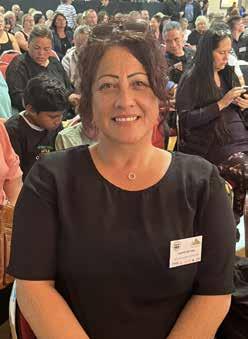
TE HAPE B and Tiroa E Trusts have supplied over 52,000 ewes to the New Zealand Shearing Championships over a relationship spanning 20 years, said vice chairperson Karyn Nathan.
that role out successfully, with pride and mana. “His children have grown up on our farms, on our whenua, and he’s part of the community in Benneydale and Te Kūiti.
“That’s also an achievement for us as a trust, having our managers be part of this kauapapa as well.
Fonterra has announced plans to close four plants at two Waikato manufacturing sites. The sites – Waitoa and Te Rapa – will continue to operate.
Fonterra director NZ manufacturing Alan Van Der Nagel said the decision made was because Waitoa’s specialty powder plant and coal centre, and two powder dryers at Te Rapa were “aging assets”. They had served well but were no longer efficient to operate.
“For these reasons, we have let our teams know of plans to close these plants.” Staff impacted by the plant closures had
all been offered job opportunities within the co-op.
At the end of last year, Fonterra opened a wood biomass boiler at its Waitoa site allowing the co-op to transition from using coal to wood biomass to process milk.
Similar switches have seen both the Te Awamutu and Hautapu sites reducing emissions by progressing to the use of wood pellets.
At the Te Rapa site, the two dryers would discontinue operations in May.
The spokesperson said this closure would impact “fewer than 10″ staff.
A significant part of Waikato Regional Councils (WRC) catchment management programme involves helping landowners/managers to better manage erosion prone catchments, particularly in the steeper parts of the region.
Loss of productive land in our hill country is estimated to cost the economy $100 to $150 million a year. The benefits include keeping soil on the hills where it is supposed to be, and reducing sediment loss and contamination into our rivers and streams and West Coast harbour catchments.
The Waikato Hill Country erosion programme is a partnership between the Ministry of Primary Industries (MPI) and Regional Councils.
The Waikato programme involves a targeted approach in catchments with the greatest erosion risks, and aims to support landowners with a suite of mitigations, including poplar pole planting, native afforestation and land retirement and reversion to native.
In the Waipā Catchment, The Waikato River Authority and WRC with the support of the Hill Country erosion fund can work together to jointly support landowners via the Waipā Catchment Plan programme with a total of $4.15million available over the next four years.
Landowners in the Kaniwhaniwha, Moakurarua, Mangarama, Mangatea,



 By Stu Kneebone Waipa/King Country Councillor Waikato Regional Council
By Stu Kneebone Waipa/King Country Councillor Waikato Regional Council
Mangarapa, Upper Waitomo and Upper Pūniu catchments may be eligible for funding assistance. Up until June 2024 (the next two months) up to 85 per cent of the cost of work is able to be provided. However from July 2024 through to June 2027, 70 per cent funding assistance will be available.
In the West Coast catchments, WRC in partnership with the MPI Hill Country Erosion fund can support landowners from now up until June 2027. Landowners within the Mōkau, Awakino, Marokopa, Kawhia Harbour and Aotea Harbour catchments may be eligible for up to 70 per cent of the cost of fencing and planting.
The total funding available for the West Coast zone catchments (note, this
includes Whaingaroa and the northern catchments of Waimai/Mangati) is $2.7 million over the next four years.
For those with marginal steep gullies and other unproductive areas that are not really suitable for cattle, this funding assistance is worth considering.
The types of work eligible include fencing to retire steep, erosion prone land (including land with native bush on it), re-vegetation of steep, erosion prone land with natives, and poplar pole planting (with sleeves to protect them from cattle) for stabilising land slips etc.
Noting that the pending plan change regulations will require exclusion of cattle from certain streams and other waterbodies, this funding assistance will not be available for work required by regulation.
However in situations where landowners are prepared to go the extra mile and go over and above the regulatory bottom lines, demonstrate real value add for the health of a catchment, and for example create a wider riparian buffer than the regulations require, then this funding assistance can be applied.
As well as mitigating erosion risk, this work also provides a range of other benefits to help future proof farming systems in hill country, including building resilience to climate change and enhancing native biodiversity.
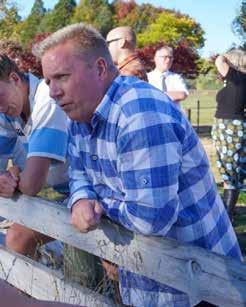
Trade and Agriculture Minister Todd McClay (pictured in Te Kūiti this month) was expected to return from China today (April 18) following the coalition government’s first official visit.
In Beijing, Mr McClay was to meet Minister of Commerce Wang Wentao, Minister of Agriculture and Rural Affairs Tang Renjian, as well as his counterpart for his forestry portfolio, Administrator Guan Zhi’ou.
He planned to discuss trade and agricultural relationship with China, and, in Shanghai, meet New Zealand businesses in-market, including small and medium enterprises across food and beverage, health and nutrition, services, and logistics sectors.















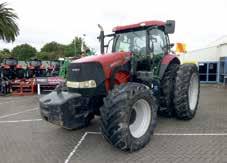






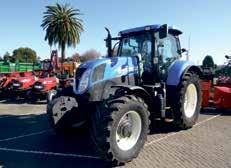



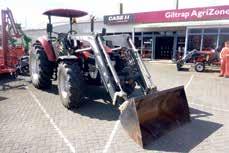










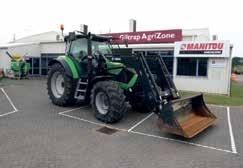





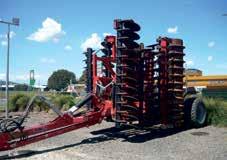
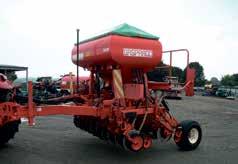




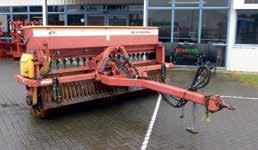




The attack was under a near constant smoke screen laid down by Allied artillery to obscure their location from the German batteries on Monastery Hill. The Māori were able to hold their positions for much of the day, but isolation and lack of armoured support and anti-tank guns made the situation hopeless.
An armoured counterattack by two tanks came in the afternoon on February 18, and A and B companies were ordered to pull back to the river when it became clear to headquarters that both attempts to break through in the mountains and along the causeway would not succeed.
The Rajputana Rifles and Gurkha Rifles attempted sweep across the slopes and ravines in a direct assault on the monastery also failed. It was across appalling terrain, the fighting was brutal, no progress was made and casualties were heavy.
The Rajputanas lost 196 officers and men, the 1/9th Gurkhas 149 and the 1/2nd Gurkhas 96. On February 18 the attacks on monastery hill were called off.
28 Battalion A and B
Companies suffered 128 out of 200 men killed, wounded or captured. The New Zealanders were withdrawn in early April following another unsuccessful attack in March, which saw desperate close-range fighting in the ruins of the town, which was bombed on March 15 in a four hour attack with artillery.
than the struggle for Cassino.
Losses for the Allied forces numbered 105,000 casualties, and the Germans suffered 80,000 casualties.
The third engagement March 15–26, waged principally by Canadian and British troops, also failed.
The fourth engagement on May 11–18, was spearheaded by the Polish Corps, which faced fierce counterattacks and suffered heavy losses. When they finally took the summit on May 18 the Poles discovered hill unoccupied, except for some wounded soldiers unable to travel. More than 900 Polish troops had died in the battle.
Former Waitomo News reporter and now Timaru resident, Tom O’connor wrote about the Casino experiences of Sargent Eric Batchelor DCM and bar M.I.D. (mentioned in despatches) in his book The Ferret.
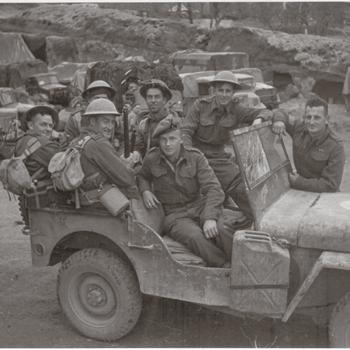
A New Zealand attack on the town failed to overrun dazed defenders. German paratroopers who survived the bombing caused heavy New Zealand casualties.
The New Zealanders seized the summit of Castle Hill, a vital height to the west between the town and the monastery. Other troops forced their way through to the railroad station.
The New Zealanders failed to dislodge pockets of German defenders in the town center, and Allied tank crews found it impossible to operate in the demolished remains of the urban center.
Freyburg reached his limit by March 23 and he recalled his battered troops and regrouped.
Of all the battles involving the Māori Battalion in the Second World War, none was more brutal or costly


With Anzac Day just around the corner, the Heraldry Curator at the National Army Museum in Waiouru has some tips about how to wear your family’s medals.
“One of the sad threads I picked up running through this story was the transition undergone by excitable young men in their late teens and early 20s at the start of the war to hardened old men in their mid-twenties when it was all over,” he said in the foreword.
“At the beginning some of their pranks and adventures were typical of over exuberant school boys pushing the boundaries of discipline and acceptable behaviour as boys always have.
“Those still alive four years later had seen and done things beyond the comprehension of people who have never served in the front lines of a world war.
“Their personalities, attitude and empathy had irreversibly changed. Nightmares disturbed their sleep, the sounds of gunfire, terrifying closeness of violent death and the screams of dying men never left their memories.
Many had difficulty readjusting to a non-violent, non-aggressive role in civilian life and some ended up in prison for actions at home that would have won them praise and medals during the war.
“Eric made that adjustment with initial difficulty and spent the rest of his life in his beloved Waimate.”

First and foremost? Wear them with pride! Their service should be remembered and honoured, and wearing their medals on a day of national remembrance allows them to be on parade one more time. There are a few rules to keep in mind though. Next-of-kin and other relatives of servicemen and women can wear their relative’s medals only on specific occasions - Anzac Day being one of them. The service medals and decorations must be mounted on a medal bar (full-size or miniature), and neck badges, sashes, sash badges, rosettes, or breast stars cannot be worn by anyone other than the recipient.
Only medals earned by the person wearing them can be worn on the left side of their chest, so if you are wearing your relative’s medals make sure they are on the right side of your chest. An easy way to remember – only your own medals are worn above your heart.
It is absolutely okay to wear replicas, and in some cases it is the best way to honour a relative. Some families choose to keep medal bars safe and protected, or on display, and wear replicas on special occasions, and others get multiple replicas to be worn by multiple family members. A medal bar should not be “broken up” with individual medals going to different family members; some say to do so negatively impacts the mana of the medal bar and the story of their service.
Don’t have your relative’s medals to wear? That’s okay! Just turning up for an Anzac Day service or wearing a poppy shows respect and honours their service.
The National Army Museum in Waiouru will be holding an 11am Civic Service on Anzac Day for anyone who wishes to attend. Discover New Zealand’s military history, engage with real life soldiers’ stories and reflect on how conflict has shaped our nation.
Open daily 9am-4.30pm.
Only medals earned by the person involved can be worn on the left side of the chest, so if you are wearing your relative’s medals make sure they’re on the right side.

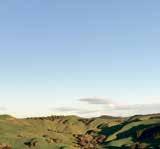
































This gorgeous 1915 villa is awaiting new owners. Character charm and spacious family living with marvellous high studs are perfect for creating living spaces catering for the demands of modern lifestyles.
Three bedroom property with three bathrooms, one off each room. A coal range sits in the kitchen surrounded by native hardwood timbers. Beautiful decorative features that can’t be duplicated today, they are the embodiment of the design of the late 1915’s. Style of living may have changed over the




intervening years, however villas like this offer the opportunity to create a home full of period charm combined with contemporary living.
An additional separate unit with kitchen and shower adds to the uniqueness of this property for a second income or extra living space for visitors or guests.
Walking distance to both New World and town centre, park and Te Kūiti Primary School a few steps away, who wouldn’t want to pick up the phone and call to view this beauty.



LOCATION | 1 Hinerangi Street, Te Kūiti
HOUSE I 86 m2
HOUSE | 3 bedrooms, 3 bathrooms, separate unit with kitchen and shower
PRICE | $510,000
LICENSED AGENT | Property Brokers Te Kūiti
LICENSED SALESPERSON | Mary Tapu0274 749 869
WEBSITE | propertybrokers.co.nz
WEB ID | OTEU182273
Revitalised beauty
Immaculately presented 1940s family home. New roof, paint inside and out, new carpet and vinyl, new deck and new wood burner. Open plan kitchen/dining flows to the larger of the two decks, ideal for entertaining and family bbqs. Five bedrooms - three double, one single and a master with walk in closet and separate shower. Situated in Mahoenui, the location is approximately 20mins from Pio Pio and Mokau. Negotiating over $460,000. 5 2 1 2.5
For Sale Buyers $460,000+
View By appointment
Web pb.co.nz/TEU176386
Mary Tapu
M 027 474 9869
E mary.tapu@pb.co.nz




This property built in 1959 offers 4 bedrooms, bathroom and double garaging. Floor plan of 110 m2 (approximately) provides plenty of room for the growing family. A open style for both living and dining area will keep the troops together for conversation while dinner is cooking.
The covered patio allows an area for that morning cuppa and conversation while keeping the elements at bay.
A decent sized yard of 832 m2, enough for an additional cabin or pool and still enough room to run around.
Within flat walking distance to town and all amenities.






This three-bedroom home, one bathroom home is now for sale. With a land area of 678ms approx. and a building area of 90m2 approx. there is plenty space for comfortable living. A outside unit will help when entertaining guest and visitors. A open plan living area with combined functional dining and lounge. Heating is provided by way of Heat Pump and Fire Box.
Enjoy outdoor living on the decking area. A fully fenced yard provides privacy and security and parking with a single carport as well as off - street parking.
Close to the St Josephs school and easy walking distance to town.








Lots 14, 41, 45,
Rosetown Realty Ltd Licensed REAA2008 Titles are now available for the last few sections available in stage one of Westridge subdivision. Reasonable covenants apply. Phone John. For Sale $220,000 each
























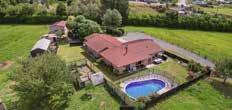










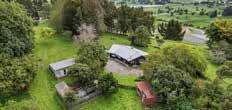

















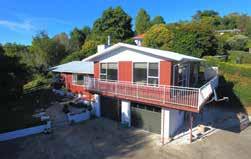
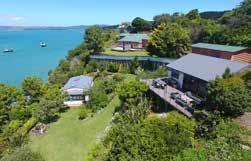





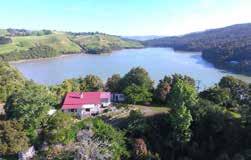


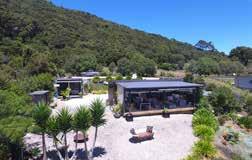



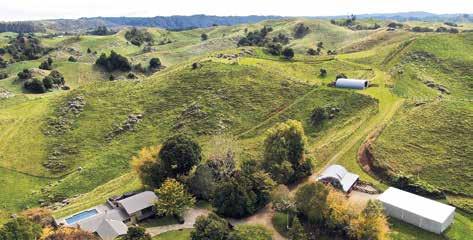




We have just listed this 3 bedroom brick home in



Friday, April 19
Start 12 noon
40 MT cows
80 2 ½ yr Angus & Angus x strs
80 18mth Angus & Angus x strs
100 18mth Hfd fries & Fries x strs
25 18mth Exotic x strs
60 18mth Angus hfrs
60 18mth Hfd Fries & Ang Fries x hfrs

Trades & Services
Hwy 43 Sheep Scanning
Have spaces available for 2024 season
Over 20 years’ experience
For a local and friendly scanner PH/Text Steve on 027 762 8000 or email stevephilpscan@gmail.com
Trades & Services
Need a Decorator - Call Now
Dave Rowe Painter & Decorator 027 290 8776 - 07 873 9104 decorator@daverowe.co.nz
Servicing the Waipa and Waitomo districts for over 20 years







Sewing machine & overlocker repairs and maintenance
Scissors/knives sharpened

Ph Neil 027 587 8538 helen.neilpotter@gmail.com


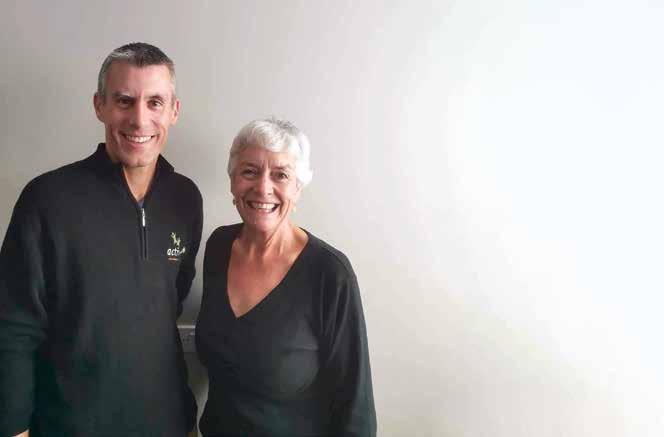




References available, GST registered.
Mike & Allana 027 350 0836 info@handy-man.co.nz

The Maniapoto Arts Fest is an event organised by Violence Free Maniapoto, a celebration of local visual and performing arts supporting a more connected community.
The VFM group are looking for an event/project manager to design, develop and deliver the next Arts Fest in 2024. The theme for this year is Celebrating Diversity.
You will be a great communicator, listening and speaking, you’ll be the one who gets stuck in doing but also engages all of the many amazing volunteers in our community to help with the doing.
You have an understanding of the diverse needs within our community, you have connections in our community and you know how to use those connections to make this event a success.



VHYSEVSHKVFZYTHDSW
TAOBROBUGJDHIDCCEP
OOLAKYJLOEGCRLOCOP
ENCNOAQLNNAALWSOIJ
REOEYGCGICORACLEKP
STIAAEIDDBTBASRFUE
SPUCANOERHKRLAUNCH
EQPGETJACKAEJDTXZR
MTSASTTACSYETEDJEU
OTAAASYDRWAZXCTWSD
TIMMIFFVUVKEPKHTRD
ODPALCABINPAQENEYE
REANZLTJSRAORTPDKR
RQNCNUHAEAIRAPLDJO
A part time role, especially through design and development stages, working in the offices of Waitomo Waipa Women’s Refuge and flexibility to work remotely.
You must be tech savvy, a creative who can ensure the i’s are dotted and the t’s are crossed. You will also be an NZ Resident, this is a short term contract that ends after the tidy up of the event, so ideally you live locally in the Waitomo District.
If you think you are the one for the job email your application to nicki@eight73consulting.co.nz –applications close on April 30, 2024.



(6)
24. Piece of paper (5)
Down 1. Not okay (12)
2. Push (5)
3. Trudge (7)
4. Rough (sea) (6)
5. Trunk (5)
6. Antiquated (7)
7. Hallowe’en tradition (5,2,5)
13. Peg back (7)
15. Monotonous (7)
16. Paper fastener (6)
18. Garden pest (5)
20. Chap (5)
VFCHUEOGWUYCIDUZZP
RWNOETMIQVKLGNIWOR
RTNRWOXFEMCCREWRKX
QCWRTFARCTVNRETSQK
ANCHOR
BOAT
BREEZE
Last week



• Strengths in working with students who have complex learning needs and require behavioural support.
Ability to work as part of a team.
Training will be provided


• Hours: between 10 - 15 hours per week, Mon - Fri, school term time only (approx. 40 weeks/year) There is room for flexibility. Conditions and remuneration are according to the Support Staff in Schools Collective. Start
(as soon as police checks are completed) This is a fixed-term contract please feel free to seek further information. To apply, please send a cover letter, CV, and names of 2 referees to Vicki Robinson principal@pokuru.school.nz

The Annual General Meeting of the Ōtorohanga RSA Inc is to be held in the Ōtorohanga Club Inc on Thursday, April 25, 2024, commencing at 0700 hours.
Will be held at 0600hrs on Thursday, April 25, 2024 at the Ōtorohanga Memorial Park, corner of Kakamutu Road & State Highway 3, near Mobil Petrol Station.
0545hrs - Parade to form up near the Ōtorohanga Butchers
0550hrs - Parade Marches to the Ōtorohanga Memorial Park
0600hrs - Service begins 0630hrs - Service ends


Administration Officer/Receptionist
Administration Officer/Receptionist
Varied role as office administrator and receptionist required for chartered accounting and business advisory practice.
Varied role as office administrator and receptionist required for chartered accounting and business advisory practice.
This position can be both varied and challenging, and would suit an experienced and self-motivated person looking to make the role their own.
This position can be both varied and challenging, and would suit an experienced and self-motivated person looking to make the role their own.






We are a rural firm that is passionate about the success of our clients and love serving the community we live in. We have a young, professional and highly motivated team who enjoys working in a supportive and down to earth environment. Could this be the position for you?
Experience and skills required:
We are a rural firm that is passionate about the success of our clients and love serving the community we live in. We have a young, professional and highly motivated team who enjoys working in a supportive and down to earth environment. Could this be the position for you?
• Have high verbal and interpersonal communication skills.
Experience & skills required:
• Ability to work independently.
• Have high verbal and written communication skills.
• Be highly organised and efficient.
• Provide attention to detail and accurate data entry.
• Ability to work independently.
• IT literacy .
• Be highly organised and efficient.
• Payroll experience would be beneficial.
• Provide attention to detail and accurate data entry.
• IT literacy .
Prescott Toyota has been in business in Ōtorohanga for over 60 years, operating a successful Toyota Dealership.
Due to an internal promotion, we are looking for a qualified mechanic to join our workshop team. You will be responsible for conducting technical checks, diagnosing faults and vehicle servicing providing quality mechanical services that ensure a high level of customer satisfaction.
This is a fulltime position 8.30am – 5pm, although some flexibility can be negotiated. If this is the role for you, then we would love to hear from you.
• Payroll experience would be beneficial.
This is a fulltime position 8.30am – 5pm, although some flexibility can be negotiated. If this is the role for you, then we would love to hear from you.
Please email your CV to holly@smithmitchell.co.nz.
Applications close 5pm, Wednesday, April 24, 2024.
Please email your CV to holly@smithmitchell.co.nz.
Applications close 5pm, Wednesday, April 24, 2024.
This is a role for a hands-on Technician with sound mechanical expertise and knowledge of vehicle engines, parts and systems. If you have knowledge of Warrant of Fitness regulations that would be an advantage.
You’ll have exceptional customer service, have great attention to detail and have the ability to juggle a busy workload while remaining calm and in control.
Whether you are recently qualified, or have years of experience under your belt we would love to hear from you!
Previous experience in a vehicle dealership service department would be an advantage.
To apply, please send your cover letter and CV to sarah@eight73consulting. co.nz. For further information, call Sarah on 873 7104.
Closing Date: Friday, April 26, 2024, but applications will be assessed as they come in so don’t delay and apply today!
Plenty of scope to build that dream home Lies to the north. 7 paddocks, 3 bay implement shed (which could be used as a workshop), yards and loading race.
Town water and power at boundary.
views
Call into our King St East, Te Kūiti office today to view them and place your order!
Waitomo District Council Office closure - ANZAC Day
Thursday 25 April 2024
Waitomo District Council’s Office, Customer Service Centre, Library and other facilities will be closed on Thursday 25 April 2024 for ANZAC Day.
We will still be available by phone on 0800 932 4357.



Meetings
Pohatuiri Pā Charitable Trust Trustees Hui-ā-Tau 2024
11am
Sunday, May 19, 2024
Pohatuiri Pā, Ngatapuwae Rd, Waitomo
AGENDA
11am Mihimihi / karakia / apologies
Minutes from last AGM – matters arising.
Financial report
Chairmans report




Approval of updated charter
1pm Karakia whakamutunga
Kaitahi – we welcome contributions to the table.
1.30pm General Meeting
A. Pā Development
B. Pā working committee.

Members of the Public and Service Organisations are invited to attend the ANZAC Memorial Dawn Service at the Te Kūiti Pā, Awakino Road, Te Kūiti. The itinerary for the Service will be as follows:
5.45am Attendees will assemble at the Awakino Road
Entranceway and wait to be called onto the Pā
Attendees will then move to the Memorial Monument on the Pā where the Ceremony will take place.
6am ANZAC Memorial Service
A light breakfast will be provided to attendees following the Service.
Members of the Public and Service Organisations are invited to attend the ANZAC Memorial Service which will be held at the Les Munro Centre, King Street East, Te Kūiti. The programme is:
7am Parade to assemble at The Lines Company, corner of King Street East and Taupiri Streets, Te Kūiti
7.15am March from The Lines Company to the Les Munro
7.30am ANZAC Service at the Les Munro Centre followed by Wreath Laying at the Cenotaph
Attendees not participating in the Parade are requested to be seated in the Les Munro Centre by 7.20am. Service organisations, Guiding and club members, and members of the public are invited to join the Parade. Please assemble behind the RSA contingent. Te Kūiti ANZAC Day Service enquiries to Waitomo District Council Phone 0800 932 4357.
All local Service Organisations and members of the public are invited to join the Returned Servicemen of the Piopio District for the ANZAC Day Memorial Service. The programme is: 10.50am Assemble at St John Building, Moa Street, Piopio 11am March from St John Building to Cenotaph at Piopio War Memorial Hall followed by the ANZAC Service and Wreath Laying
Tea and Coffee will be available to attendees following the Service. All are welcome to participate in both the Parade and Service. Members of the public are also invited to bring wreaths to lay at the Cenotaph as part of the proceedings.
Piopio ANZAC Day Service enquiries to Jenny Brodie - 07 877 8033
The organisers of this year’s Awakino ANZAC Day Service would like to invite all local Service Organisations and members of the public to join the Returned Servicemen of Awakino and the surrounding District for the ANZAC Day Memorial Service.
11am ANZAC Service at the Awakino Memorial Hall, Briscoe Street, Awakino
A light luncheon will be available to attendees following the Service Awakino ANZAC Day Service enquiries to Dorothy Lowry - 06 752 9123





Waikato Regional Council advises that under Resource Consent 124871 spraying of pest plants growing in aquatic and semi-aquatic locations will continue over the next three months.
Pest plants to be sprayed are listed in the Regional Pest Management Plan and include (but are not limited to): alligator weed, Manchurian wild rice, sagittaria, Senegal tea, spartina and yellow flag iris. Herbicides to be used are haloxyfop, imazapyr, metsulfuron-methyl and triclopyr. Application method is location dependent and may be by helicopter, gun and hose, mistblower or knapsack.
Operational areas are spread throughout the region and include (but are not limited to):
• Lakes Whangape and Waikare
• Te Otamanui Lagoon
• Waihou, Piako and Ohinemuri rivers
• Waikato River (from Horotiu to Port Waikato)
• Whangamarino and Maramarua rivers
• numerous smaller urban and rural sites.
Spraying is weather dependent and will occur during daylight hours on any day, including weekends but excluding public holidays.
For more information or to request to be notified visit www.waikatoregion.govt.nz/aquaticspraying or call Waikato Regional Council’s biosecurity pest plants team on 0800 800 401. Occupiers who have already
Enquires please contact trustee secretary Dawn Magner on 027 449 4145
Nau mai haere mai



Meetings
Mangapeehi Paa Trustees AGM
Saturday, May 4, 2024
10am at Mangapeehi Pa
Agenda:
9am Registration
10am Karakia/Mihimihi
Apologies
2023 AGM minutes
Matters arising from 2023 AGM
Chairperson’s report
Financial report 2023
Startegic Plan update
Marae committee report
Wananga update
Charter ratification - if any Trustees nomination and election to rotation for Shakyra Te Aho, Pei Whatarangi and Rangi Te Po Whatarangi
General business
Whare Ki Rereahu Kura Tau Presentation
Mihi mutunga/karakia
Please bring a plate
For enquiries 027 301 0059
Public Notices
King St East, Te Kūiti
SENIORS COFFEE GROUP
Friday, April 19 10.30am Guest speaker
Mayor John Robertson
All welcome
Robyn Lindstrom of Ac�ve+ Te Kūi� would like to advise that the Te Kūi� Physiotherapy Clinic has been sold to Maneesh and Emma Nahna of Te Kūi�, with takeover day on Friday, April 26. The clinic will be taken out of the Ac�ve+ Franchise and from Friday, April 26 will trade as Move It Physio.
Robyn and Craig would like to thank and acknowledge the amazing team of Te Kūi� staff which they have had over the last 35 years and give a warm thanks to the community of Te Kūi� who have supported our business over these years. We wish Maneesh and Emma success in their new venture.
The Te Kūiti 4 H Community Trust provides a mobility van to the people of Te Kūiti, to transport anybody with mobility problems around the district and to the St John Shuttle bus in Ōtorohanga. The Trust was formed in 1992 and operates with the generous support of volunteer drivers. A partnership was developed with the Te Kūiti Community House Trust to coordinate the service in 2013.
Te Whānau Kōhanga Reo o Piopio
AGM Hui
Mokau Kohunui Marae, 18 Moa Street, Piopio
Wednesday, May 15, 2024 @ 6pm
:
• Karakia
• Mihi
• Apologies
• Minutes of the previous AGM
• Matters arising from the previous minutes
• Correspondence
• Chairperson’s report
• Kaiako report
• Treasurer’s report / Financial statements
- Budget forecast
• Election of officers
- Chairperson
- Secretary
- Treasurer
• General Business
• Next Meeting Date
Nau mai, haere mai
Contact: Ariana Thompson-Bell 07 877 8185
THE FAT OWL LIMITED, 12 Ruru Street, Piopio has made application to the District Licensing Committee at Te Kūiti for the renewal of an On-licence in respect of premises situated at 12 Ruru Street, Piopio and known as FAT OWL MOTEL BAR AND EATERY. The general nature of the business to be conducted under the licences is that of resturant. The days on which and the hours during which alcohol is to be sold under the On-licence are Monday to Sunday 9am to midnight the following day.
The applications may be inspected during the ordinary office hours at the office of the District Licensing Committee at Waitomo District Council, Queen Street, Te Kūiti. Any person who is entitled to and wishes to object to the issue of the licences may, not later than 25 working days after the date of the publication of this notice, file a notice in writing of the objection with the Secretary of the District Licensing Committee at Waitomo District Council, PO Box 404, Te Kūiti 3941.
No objection to the renewal of a licence may be made in relation to a matter other than a matter specified in Section 131 of the Sale and Supply of Alcohol Act 2012 This is the first publication of this notice.
PANORAMA MOTELS LTD, Private Company, 59 Awakino Rd, Te Kūiti has made application to the District Licensing Committee at Te Kuiti for the renewal of an On-licence and renewal of an on licence in respect of premises situated at 59 Awakino Rd, Te Kūiti and known as Panorama Motor Inn. The general nature of the business to be conducted under the licences is that of a motor inn. The days on which and the hours during which alcohol is to be sold under the licence are Monday to Sunday 10am to 2am the following day. Good Friday, Easter Sunday, Christmas Day and up to 1pm ANZAC Day for the purpose of dining only and 24 hour/seven days for those living on the premises. A variation is being applied for the licenced area. The application may be inspected during the ordinary office hours at the office of the District Licensing Committee at Waitomo District Council, Queen Street, Te Kūiti. Any person who is entitled to and wishes to object to the issue of the licences may, not later than 25 working days after the date of the publication of this notice, file a notice in writing of the objection with the Secretary of the District Licensing Committee at Waitomo District Council, PO Box 404, Te Kūiti 3941. No objection to the renewal of a licence may be made in relation to a matter other than a matter specitied in Section 131 of the Sale and Supply of Alcohol Act 2012. This is the first publication of this notice.

Meetings
Ōtorohanga Historical Society
AGM
Sunday, April 28, 2024 11am at the Ōtorohanga Museum
We welcome everyone interested in our local history
Church Notices
St David's Presbyterian Church Ranfurly St, Ōtorohanga

Services Sunday 10am Session clerk Ph 07 873 8735
Room bookings
Ph Nina 027 237 2382
Meetings

North King Country Motorcycle Club AGM
Everyone is welcome Come along to stay informed and become involved. Date – Wednesday, May 8 at 7.15pm Venue
Church Notices
10 Sheridan St, Te Kūiti
An Assemblies of God church
10:30am Sunday
Church Notices
Deaths
BARTON, Rachel Ann (nee Bell): Born October 29, 1969. Passed away surrounded by her loving family on April 2, 2024. Loving wife of Jonathan, mother of Emma, Eleanor and Ethan. A celebration of Rachel’s life will be held at home on Saturday 20th April at 2.30pm. RSVP at your earliest opportunity to Rachel@ greenplan.co.nz.
KENNARD, Dania
St Bride's Anglican Church Haerehuka St Ōtorohanga
SUNDAY Morning service 10am Ph 07 873 7006
PIOPIO ARIA MŌKAU CO-OPERATING PARISH
All Saints 22 Moa St
Every Sunday 10am Service
St Peter’s By The Sea, 25 Aria Tce, Mōkau 1st and 3rd Sunday 2pm Service
Piopio contact: 07 877 8097
In Memoriam
CARTER, Jean: 19.07.1923 –18.03.2023. Devoted and much-loved mother, aunty and friend. A very special and spirited lady. “What you leave behind is not what is engraved in stone monuments, but what is woven into the lives of others” xxx
10 Sheridan St, Te Kuiti
Pastor Terry & Rowena Bradley 07 878 8694 021 703 008

We welcome you to our 10.30am Sunday service. If you are unable to attend, please email officejourneynz@gmail.com for the video recording Grace, peace and strength
An Assemblies of God Church
Corina: Peacefully at Waikato Hospital on Monday, April 15, 2024, surrounded by her loving daughters. Aged 52 years. Dearly loved partner of Dean. Cherished and much loved mother to Jasmin and Caleb, Cayt and Aaron, Alex and Conrad. A loved cousin, aunty and friend to many. A celebration of Corina’s life will be held at VJ Williams & Sons Chapel on Friday, April 19 at 1pm, followed by a private cremation. All communications to Kennard Family C/- PO Box 241, Te Kūiti 3941. VJ Williams & Sons, Funeral Directors Association of NZ Harvest
Mōkau contact: Mrs Dorothy Lowry 06 752 9123
Raffle Results
TE KŪITI LYCEUM
CLUB: Hamper 63 Jo Barnett, No.1 $50 59 Jo Barnett, No 2 $ 50 116 Rob Drew. Drawn by NZ Police. Thanks to all supporters sale day and raffles.
CITIZEN’S Advice Bureau Te Kūiti muster free grocery raffle.
Winner: Rita Hetherington. Personal details of all entries have been destroyed.
of Beattie

L Liddington; Draw 6 - Bathroom pack L Grice; Draw 7 - Mixed Basket D Murray; Draw 8 - $100 Thirsty Weta voucher Y Le Fleming. Thank you to all our wonderful supporters.
BRIGGS, Robin: Rosemary and family would like to sincerely thank everyone for their love and support following Robin’s recent passing. We have been humbled by the generosity, compassion and prayers during this difficult time from those who knew him. We will cherish his memory forever in our hearts. Please accept this as our personal acknowledgement.

TANGIHAERE, HEREMAIA (IKE): On behalf of Olive and whanau, we wish to express our appreciation for your presence, prayers, thoughts, koha, mahi and expressions of aroha. To our paepae in Taumarunui and Te Kūiti Pa, to our ministers, you have all lightened the burden of losing our Dad and Pop. To those friends who kept us fed during Dad’s short illness, we are eternally thankful. To our wonderful district nurses, nga mihi aroha. Words cannot express our gratitude to you all. Kua hinga koe e te matua, e te Pāpā Heremaia, takoto mai i runga i te rangimārie o te Karaiti. E te pou tokomanawa e kore rawa koe e warewaretia, takoto i runga i te aroha.









